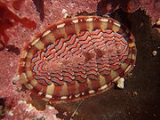
Tonicella lokii
Encyclopedia
Tonicella lokii, commonly known as the flame lined chiton or Loki's chiton, is a chiton
in the lined chiton genus Tonicella
.
is extremely similar but does not have radiating bands on the girdle. Tonicella undocaerulea
is also very similar but does not have the radiating bands on the girdle and also lacks a dark border to the concentric blue lines on the anterior plate. Mopalia spectabilis
looks superficially similar due to its bright blue wavy lines on the valves and its radiating bands on the girdle, but differs in having a hairy girdle.
Chiton
Chitons are small to large, primitive marine molluscs in the class Polyplacophora.There are 900 to 1,000 extant species of chitons in the class, which was formerly known as Amphineura....
in the lined chiton genus Tonicella
Tonicella
Tonicella is a genus of chitons known as the lined chitons. The genus name derives from the Greek tonos and cell .-Species:Species within the genus Tonicella include:...
.
Size and description
Like most chitons in this genus, T. lokii has blue, white, purple or black zig-zaged lines on each of the eight valves. The background color of the valves is often brown or red, but can also be bright blue or yellow to orange. The girdle is hairless and brown to red or pink. It has radiating bands and often bears a yellow or white broken concentric line, alternating with radiating bands.Similar species
Tonicella lineataTonicella lineata
Tonicella lineata, commonly known as the lined chiton, is a species of chiton.-Size and description:T. lineata is a very colorful chiton, having blue, purple or black straight or zig-zag lines on each of the eight valves. The background color of the valves is often brown or red, but can also be...
is extremely similar but does not have radiating bands on the girdle. Tonicella undocaerulea
Tonicella undocaerulea
Tonicella undocaerulea, commonly known as the Blue Lined Chiton, is a species of chiton.-Size and description:The Blue Lined Chiton has a head plate with zigzag white concentric lines without a dark border. It commonly has bright electric blue stripes and flecks when alive...
is also very similar but does not have the radiating bands on the girdle and also lacks a dark border to the concentric blue lines on the anterior plate. Mopalia spectabilis
Mopalia spectabilis
Mopalia spectabilis, commonly known as the Red-flecked Mopalia, is a species of chiton.-Size and description:M. spectabilis is a chiton that has a central area of plates 2-7 pitted in longitudinal rows. The girdle commonly banded light orange and brown. This species nearly always exhibits bright...
looks superficially similar due to its bright blue wavy lines on the valves and its radiating bands on the girdle, but differs in having a hairy girdle.

